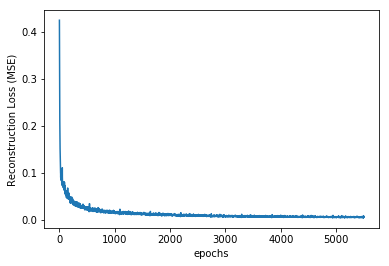We proceed with the recipe as follows:
- We import the necessary modules:
import tensorflow as tf
import numpy as np
from tensorflow.examples.tutorials.mnist import input_data
import matplotlib.pyplot as plt
%matplotlib inline
- Load the MNIST dataset from TensorFlow examples:
mnist = input_data.read_data_sets("MNIST_data/")
trX, trY, teX, teY = mnist.train.images, mnist.train.labels, mnist.test.images, mnist.test.labels
- Define the SparseAutoEncoder class, which is very similar to the autoencoder class in the previous recipe, except for introducing the KL divergence loss:
def kl_div(self, rho, rho_hat):
term2_num = tf.constant(1.)- rho
term2_den = tf.constant(1.) - rho_hat
kl = self.logfunc(rho,rho_hat) + self.logfunc(term2_num, term2_den)
return kl
def logfunc(self, x1, x2):
return tf.multiply( x1, tf.log(tf.div(x1,x2)))
We add the KL constraint to the loss as follows:
alpha = 7.5e-5
kl_div_loss = tf.reduce_sum(self.kl_div(0.02, tf.reduce_mean(self.y,0)))
loss = self._loss + alpha * kl_div_loss
Here, alpha is the weightage given to the sparsity constraint. The complete code for the class is as follows:
class SparseAutoEncoder(object):
def __init__(self, m, n, eta = 0.01):
"""
m: Number of neurons in input/output layer
n: number of neurons in hidden layer
"""
self._m = m
self._n = n
self.learning_rate = eta
# Create the Computational graph
# Weights and biases
self._W1 = tf.Variable(tf.random_normal(shape=(self._m,self._n)))
self._W2 = tf.Variable(tf.random_normal(shape=(self._n,self._m)))
self._b1 = tf.Variable(np.zeros(self._n).astype(np.float32)) #bias for hidden layer
self._b2 = tf.Variable(np.zeros(self._m).astype(np.float32)) #bias for output layer
# Placeholder for inputs
self._X = tf.placeholder('float', [None, self._m])
self.y = self.encoder(self._X)
self.r = self.decoder(self.y)
error = self._X - self.r
self._loss = tf.reduce_mean(tf.pow(error, 2))
alpha = 7.5e-5
kl_div_loss = tf.reduce_sum(self.kl_div(0.02, tf.reduce_mean(self.y,0)))
loss = self._loss + alpha * kl_div_loss
self._opt = tf.train.AdamOptimizer(self.learning_rate).minimize(loss)
def encoder(self, x):
h = tf.matmul(x, self._W1) + self._b1
return tf.nn.sigmoid(h)
def decoder(self, x):
h = tf.matmul(x, self._W2) + self._b2
return tf.nn.sigmoid(h)
def set_session(self, session):
self.session = session
def reduced_dimension(self, x):
h = self.encoder(x)
return self.session.run(h, feed_dict={self._X: x})
def reconstruct(self,x):
h = self.encoder(x)
r = self.decoder(h)
return self.session.run(r, feed_dict={self._X: x})
def kl_div(self, rho, rho_hat):
term2_num = tf.constant(1.)- rho
term2_den = tf.constant(1.) - rho_hat
kl = self.logfunc(rho,rho_hat) + self.logfunc(term2_num, term2_den)
return kl
def logfunc(self, x1, x2):
return tf.multiply( x1, tf.log(tf.div(x1,x2)))
def fit(self, X, epochs = 1, batch_size = 100):
N, D = X.shape
num_batches = N // batch_size
obj = []
for i in range(epochs):
#X = shuffle(X)
for j in range(num_batches):
batch = X[j * batch_size: (j * batch_size + batch_size)]
_, ob = self.session.run([self._opt,self._loss], feed_dict={self._X: batch})
if j % 100 == 0:
print('training epoch {0} batch {2} cost {1}'.format(i,ob, j))
obj.append(ob)
return obj
- Next, we declare an object of the SparseAutoEncoder class, perform the fit on the training data, and compute the reconstructed image:
Xtrain = trX.astype(np.float32)
Xtest = teX.astype(np.float32)
_, m = Xtrain.shape
sae = SparseAutoEncoder(m, 256)
#Initialize all variables
init = tf.global_variables_initializer()
with tf.Session() as sess:
sess.run(init)
sae.set_session(sess)
err = sae.fit(Xtrain, epochs=10)
out = sae.reconstruct(Xtest[0:100])
- Let's see the variation of mean squared reconstruction loss as the network learns:
plt.plot(err)
plt.xlabel('epochs')
plt.ylabel('Reconstruction Loss (MSE)')
The plot is as follows:

- Let's see the reconstructed images:
# Plotting original and reconstructed images
row, col = 2, 8
idx = np.random.randint(0, 100, row * col // 2)
f, axarr = plt.subplots(row, col, sharex=True, sharey=True, figsize=(20,4))
for fig, row in zip([Xtest,out], axarr):
for i,ax in zip(idx,row):
ax.imshow(fig[i].reshape((28, 28)), cmap='Greys_r')
ax.get_xaxis().set_visible(False)
ax.get_yaxis().set_visible(False)
We get the folllowing result:

